Jalebi
ਜਲੇਬੀ
Hollow batter spirals, filled with saffron syrup
Ingredients:
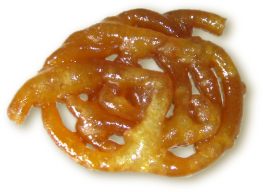 | Finished Jalebi
|
Batter:
- 1 cup of plain white flour;
- 1 heaped tablespoon of rice flour and/or besan /gram flour*;
- 1 teaspoon of yeast or baking powder**;
- If you are using yeast, 1 teaspoon of sugar;
- 1 teaspoon of sunflower oil; and,
- Warm water (cold water if you are using baking powder instead of yeast).
- Sunflower oil for frying;
* if the white flour you get is strong - bread-making flour - you will need to reduce the protein content (specifically the gluten) by adding another flour that doesn't have gluten in it. Whilst gram flour has a lot of protein in it (around 22%), there is no gluten in it so it will dilute down the wheat flour all right. If you don't reduce the gluten content, the batter you will make can end up quite thick and 'gloopy' which does not pipe too well.
** this is to make it expand a bit. With the yeast, it saturates the batter with CO2 and when it hits the hot oil, that comes out of solution and foams. The baking powder has the same effect. Note that the water in the batter will boil and expand as well.
Syrup:
Follow the Saffron Syrup recipe here
Utensils:
- a small frying pan - around 10" will do;
- a bowl to mix the batter in;
- a large spoon to put the batter in the Jalebi bag with;
- a Jalebi bag or, a piping bag (icing)***;
- a spatula for handling Jalebis in the oil;
- a milk pan;
- a fork for holding the Jalebis down in the syrup and then fishing them out afterwards; and,
- a dish to put the final product on.
*** Some people have used those tomato sauce squeezy containers. You just want something that you can put the batter in and squeeze without the hole changing its size - you need a hole around 3 or 4 mm in diameter. A plastic bag will not do because the nozzle needs to be a stable size - you don't want it to grow when you squeeze harder as the cut-off corner of a plastic bag would do.
Method:
Batter:
In a mixing bowl, mix the flours. If you are using baking powder instead of yeast, add that as well. Then, add the teaspoon of sunflower oil.
Next, fill a cup (one third of a pint) with water. If you are using baking powder, make it cold water. If you are using yeast, make it warm water and add the yeast to it - live yeast is better because it gets to work quicker.
Add the water to the flour and mix, adding more water as needed until a batter consistency is achieved - (not too gloopy, not too runny - you've all seen the consistency of the batter they use in a fish and chip shop, try for that but a little bit runnier - it will thicken up).
Next leave it for an hour but get on with the next stage.
Syrup:
You should have your Saffron Syrup made by this stage.
Jalebis:
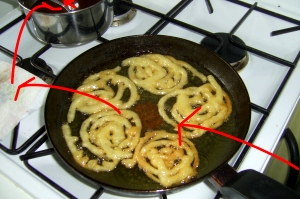 | Set up a methodical system
|
In the same what that you would when making pancakes you need to set up a production line of sorts
I do this by having the batter on one side of the stove, next to the frying pan, then a piece of kitchen towel, then the syrup and then the dish. Make sure that you don't have the kitchen roll so close to the frying pan that it catches fire.
This means that you are not trailing dripping batter in your syrup or syrup into your hot oil (insert your own favourite disaster scenario here..) and so on.
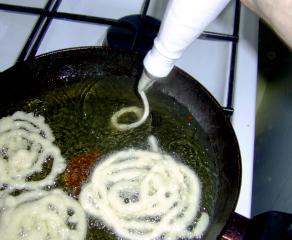 | Pipe the batter into the oil
|
Put around ½" (1.5cm) depth of sunflower oil in the frying pan. Heat it up until putting a drop of batter in it makes the batter come to the surface within 5 seconds or so but that the oil is not so hot that it browns straight away. The browning time should be 2 to 3 minutes.
Half fill your piping/Jalebi bag and then pipe it into the hot oil, using a quick, spiralling motion.
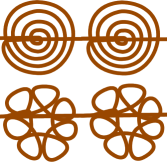 | Make interlocking spiral patterns
so that they don't fall apart |
When you do this, don't do perfect spirals, run a radial line across the spirals so that there is at least something holding them together - the idea is that you are making something that will hold together in one piece when you pick it up, not something that is a fried starch version of a spring.
Alternatively, you can make loops like a daisy or, anything you like - there are plenty of videos on the Internet showing you people making these. The more 'inter-loop cross-linking' there is, the more stable it is when you pick it up.
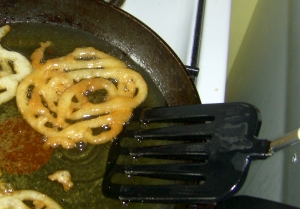 | Separate them to turn them
|
When the batter has started to harden, separate the Jalebis so that they are easier to handle.
After a minute or two, the underside will have browned and you can turn them over. If you had left them as one large sheet, it would splash hot oil when it turned over.
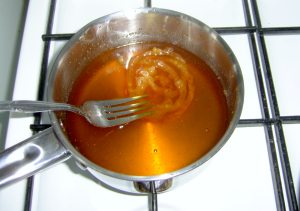 | Hold them under the surface
of the hot syrup so they suck it up |
Once they have cooked on both sides, take them out and rest them on the paper towel for a few seconds (literally just 2 seconds or so, we are trying to mop up some of the oil without letting them cool down - they need to be hot for the next stage).
Then, put them in the hot syrup. They should make a sizzling sound (the water in the syrup boiling).
Put the fork on top of them straight away to hold them down so that they are completely submerged.
The next thing that happens is that the steam inside the Jalebi collapses and sucks the hot syrup inside it.
 | A finished Jalebi
|
Once they look like the one on the right, pick them up with the fork and allow them to drain for a few seconds and then put them in the dish (don't put kitchen towel in this dish - they will just stick to it).
 | If you don't eat them whilst you make them
you can end up with this many or more |
The Jalebis will cool down and the syrup will harden slightly (this is from water loss caused by the sugar syrup being hot ... cold sugar syrup makes soggy Jalebis).
Remember to turn off the heat under the oil.
The next step is to eat them. They are best eaten whilst they are still a bit warm (but not too hot - remember that they have hot sugar syrup in them when they have just been made).
They will keep for a day or two but not much longer than that (water in the atmosphere will make them go soft).
Copyright
©2005 - 2021
P.A.Grosse. All Rights Reserved
|